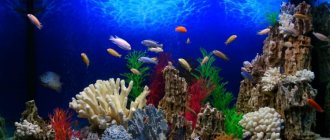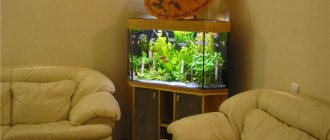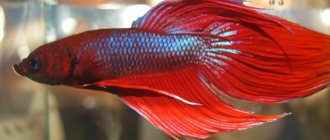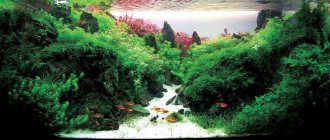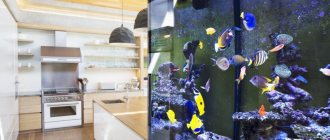The seascape is one of the most beautiful views. An aquarium with marine life will always attract attention and please the eye. But a real marine aquarium is an expensive pleasure. Its design in a pseudo-sea style will help create the illusion of an underwater world in the office or at home. This style of aquarium keeping is popular now. After carefully studying the instructions, even a beginner can make a pseudo-sea aquarium with his own hands.
This aquarium is easy to maintain
Shape and dimensions of the aquarium
We start by choosing a suitable vessel for our underwater kingdom. Any aquarium is suitable for a pseudo-sea: round, oval, rectangular, trapezoidal, flat or volumetric. The main thing is that the height of the walls of the vessel does not exceed 50-60 cm. Firstly, such aquariums are intended for bottom fish that do not swim in the upper layers of water. Secondly, filling a tall aquarium with coral structures is very difficult.
ATTENTION: For pseudo-sea, vessels with a volume of 150 liters or more are usually used. In a small aquarium, after placing the soil and decorations, the fish will be cramped.
Return to content
Characteristics of pseudomarine aquariums
A pseudo-sea aquarium is an ideal decorative element. It is introduced into various rooms: bathroom, living room, nursery, office. The only condition is compliance with the style and focus.
To create an aquarium in the pseudo-sea style, tanks of various sizes and shapes are used. For these purposes, round, trapezoidal or square containers are used. But the height of the selected tank is no more than half a meter. What are the height restrictions?
- Bottom fish that do not move above are placed in such containers.
- Introducing water, vegetation and pets into a tank with high sides is problematic.
The volume of a suitable container is no more than 150 liters.
Decorative design
Once you have decided on the shape and size of the aquarium, you can begin decorating the interior space.
Background
To create the illusion of complete immersion in the underwater world, a decorative film of blue, dark blue or black is glued to the back wall of the aquarium. Against this background, fish and corals look very harmonious. You can also use film depicting corals, underwater plants and inhabitants of the deep sea.
To ensure that the background sticks evenly, you need to:
- clean the back outer wall of the aquarium from dirt;
- apply a little glycerin to the film and press it to the glass;
- remove air bubbles from under the film.
IMPORTANT: You can remove air bubbles from under the film using a regular ruler or other similar object. If this is not done, the bubbles will be clearly visible through the water column.
Priming
As soil for the pseudo-sea, you can use coarse single-color sand, coral chips, white quartz with 3-5 mm granules, or synthetically colored substances. For every 10 liters of aquarium volume, reserve 1 kg of soil, plus add 2-3 kg additionally for the entire volume of water.
IMPORTANT: Soil made from marble chips increases water hardness. In a pseudo-sea, the water will already be hard due to shells and corals, and the presence of marble chips will only aggravate the problem. Therefore, it is better not to use it.
Stones
Large, porous stones with jagged edges, such as Kenyan stone or sandstone, are suitable for a pseudosea aquarium. It is better to choose stones with holes of different shapes and sizes. But it is better to avoid pebbles and stones of regular round shape, since they are more often found in fresh water bodies.
To prevent the bottom of the aquarium from bursting due to uneven loading, it should not be covered with stones. You can avoid using them altogether, since stones consisting of clay, lime and sand increase water hardness, and not all aquarium inhabitants like a hard environment. But without stones, it will be much more difficult to lay out coral slides.
Scenery
When decorating a pseudo-sea aquarium, use corals, shells, grottoes, colored rolled glass and other decorative elements. Don’t try to fill the entire bottom with decor; pick a few truly original items.
When placing decorations, remember the simple rules of composition. Place a large decorative element in the center, around which form hills and lowlands in a chaotic manner, and arrange small decorations. Place shells, grottoes, terraces and other secluded places for fish randomly and surround them with stones whose shape is far from ideal.
HELP: If you decide to place a shell brought from the sea into the aquarium, leave it for several days near the anthill. The ants will remove any remaining organic matter and clean the shell until it shines. All that remains is to rinse it under running water and pour boiling water over it.
Corals
The underwater space can be decorated using corals brought from the sea. But first they need to be processed:
- Boil the corals and brush them thoroughly with a medium-hard brush. This is a fast and effective method, but the corals become fragile during boiling.
- Treat the corals with a gentle bleach, and then soak them in water for 2-3 weeks. The water in which corals are kept must be changed regularly. This method requires more time, but allows you to maintain a strong coral structure.
But it is better not to use decorative corals, because they are often varnished and impregnated with substances that are harmful to fish.
Plants
Live plants are not used in the pseudosea. Firstly, they do not tolerate alkaline water well. Secondly, cichlids are not averse to nibbling on their delicate green sprouts and digging in the soil. Therefore, it is better to use artificial plants made of silicone or plastic, which are harmless to the inhabitants of the aquarium and have high decorative properties. The presence of artificial plants will enliven the underwater kingdom and allow you to disguise the equipment for filtration and aeration of the reservoir. 3-5 plants of different heights are enough for a pond.
So, when decorating a pseudo-sea, you must first fill the aquarium with soil, then place corals, stones, grottoes, shells and other decorative elements. When the formation of the exposure is completed, the bottom and decorative elements should be covered with a thin plastic film and carefully fill the vessel one third with water. After this, you need to remove the film and add water to the optimal level.
Return to content
Design Tips
African cichlids tend to be very pugnacious. In order for fish to hide from each other and rest, you will need many shelters - grottoes, caves. They can be laid out from stones, corals and driftwood. Also, decorations can be used to divide the pseudo-sea into several zones. The main object - a coral, stone or shell - is placed in the center, and hills and reefs are lined up on the sides. This will allow you to create the right composition.
The design of the pseudo-sea does not support symmetry. There should be a carelessness in the design, as if part of the natural seabed was cut out and placed in an aquarium.
Equipment
For a pseudo-marine aquarium, you need to prepare a powerful filter, lighting fixtures, a heater, a thermometer to control the temperature and an aerator.
Filter
To prevent the beautiful seascape from being spoiled by green algae, it is necessary to create a current in an artificial reservoir. To do this, you should use a powerful bottom filter with the functions of mechanical, chemical and biological water purification. The Professional 3 or Eheim filters are perfect for this role.
Lighting
In a pseudo-marine aquarium, lighting plays an important role. As a rule, the main lamp is installed closer to the front wall of the aquarium. This allows you to show the scenery in the most advantageous light.
For a pseudo-sea style aquarium, fluorescent, halogen and neon lamps with a cool bluish light are most suitable. Under neon lights, corals and other white decorative elements look even whiter. You can also purchase special lamps designed for marine aquariums. For a pseudo-sea, two such lamps located at the front wall are more than enough.
WARNING: If the lighting in the aquarium is too intense, green algae will appear in the water. To prevent this from happening, artificial lighting should be turned on only for 5-6 hours a day and the substrate should be siphoned more intensively.
Return to content
What is a pseudo-sea?
Unlike marine aquariums, the pseudosea has caused a real boom among aquarists. It has become a look-alike style that is a more affordable copy of the mini-sea.
Its main feature is the fact that the pseudosea is a freshwater aquarium. It does not contain plants, and the decor is sea shells, corals, and large pebbles. Large and colorful cichlids, which are similar to sea inhabitants, are chosen as pets. To create the effect of blue shimmering water, special fluorescent lamps are used.
Fish
The most popular inhabitants of the pseudo-sea are cichlids - large and bright fish that live in fresh water. These fish actively dig the ground and defend their possessions, so the pseudosea cichlid should be spacious, and the stones on which the corals are anchored should be large and stable.
Also suitable for a seascape are red silversides, mollies, swordtails and other brightly colored fish that visually resemble their marine relatives and are not afraid of hard, alkaline water with an abundance of corals and shells. Haplochromis cornflower will fit perfectly into underwater landscapes with a black background and bright lighting.
As for snails, they are not kept in the pseudo-sea, or they prefer unusual species, such as “Pagoda” or “Devil’s Thorn”. Corydoras and ancitrus catfishes are suitable for the role of orderlies of pseudo-marine soil.
Return to content
Decoration of an aquarium. Where to begin?
First of all, you need to imagine what the finished pseudo-sea aquarium will look like: what decorative elements are worth purchasing, soil material, background color, fish species, arrangement of the aquarium. Once an accurate picture of the future aqua world emerges in your head (or on paper), you can begin to implement it.
To design an aquarium in the pseudo-sea style, you will need a large capacity - at least 150 liters.
Shape and volume of the aquarium
To design this style, you will need a large container - at least 150 liters. It will solve two problems at once - no fights between fish, and more space to bring your dream aquarium design to life. The optimal height of the walls for a pseudo-sea is 50 cm. In low aquariums it is easier to build coral reefs and slides.
The shape of the container for this style can be any - standard rectangle, delta, ball.
Priming
The ideal option would be marble or coral chips, which resemble coarse sea sand. For every 10 liters of aquarium volume, 1.5 kg of soil is poured.
Plants and decor
The main elements of the pseudo-sea are corals and sea shells. Since you can't use live corals, synthetic substitutes will do the job.
Stones of non-standard shapes and sizes will be an excellent decoration. You should choose shell rock, sandstone and limestone. Before putting them in water, you should carefully inspect the surface for rust, cracks and crevices. The stones are then washed with running water and boiled for 15 minutes.
You can add driftwood to the pseudo-sea aquarium design. It should be remembered that some types of trees are not suitable for keeping in aquariums because they contain acids. These do not include only mangroves and cork trees.
If the snag has colored the water an amber color, you can add activated carbon tablets to the filter. It will not only cleanse the color, but also eliminate harmful impurities.
The main elements of the pseudo-sea are corals and sea shells. Since you can't use live corals, synthetic substitutes will do the job. They are environmentally friendly, durable and will not harm either the fish or the walls of the container. You can also prepare real corals by first boiling them and rinsing them in water. Sea shells should not be boiled. This will cause them to lose their pearly shine. It is enough to pour boiling water over them several times.
The pseudosea aquarium must have enough free space. Make sure that stones and other heavy decorations press evenly on the soil and base of the container. The pseudo-sea style does not provide for planting living plants, but they can be replaced with plastic ones.
You can add driftwood to the pseudo-sea aquarium design. It should be remembered that not all types of trees are suitable for keeping in aquariums.
Caring for real decorative elements is complex and regular. In addition, over time, water will begin to leach calcium from the shells, making the environment hard. Not every fish will be able to withstand it. Therefore, when creating a pseudo-sea, it is recommended to use artificial decor. It can be boiled and washed countless times, and the color will remain the same bright for a long time.
Pseudo-sea inhabitants
In most cases, Malawi cichlids, dolphins, zebras, red parrots, Lombardos, Melanchromis maigano and other bright and unusual species become the inhabitants of the pseudo-sea. You can add snails, shrimp or catfish, which will clear the walls of the aquarium from thickets.
The number of fish in the pseudo-sea is determined at the rate of 1 individual per 7-10 liters of water. You should not overpopulate the cichlid fish so that the fish feel comfortable in their “new home”.
In most cases, cichlids become residents of the pseudo-sea
Equipment
Be sure to have a powerful filter and compressor. The absence of flora will increase the load on the biobalance of the aquaworld, so a more powerful unit is needed. A sterilizer and thermostat will also be a useful purchase. To tint the water an azure blue and highlight the fish and scenery, you will need fluorescent lamps in cool shades. Since there is no vegetation in the water, the duration of daylight hours should be no more than 4 hours.
Twice a month you need to clean the soil from fish waste and change a quarter of the water volume. Once every few months, you need to wash plastic plants and corals from plaque.
Imitation of sea reality
Such an aquarium is the creation of the illusion of a marine aquatic environment with special decorations and its underwater inhabitants. Instead of salt water, it contains fresh water and, accordingly, fish and all living creatures will be fresh water.
Using special techniques will help achieve such a close match with the natural seascape that only a specialist will be able to notice the difference. A true saltwater aquarium requires expensive maintenance. It is necessary to maintain water parameters and ensure the growth of corals, vegetation and fish. The pseudosea aquarium is easy to maintain.
In this video you will learn more about the pseudosea:
General recommendations
Tones for a pseudo-sea can be either warm tropical or cold. This directly depends on the interior. In a house or apartment, it will look great in the living room. If you have a large bathroom, you can place it there too.
It is perfect for the office, creating a favorable emotional background. It can be located in the common hall. Its shape can be rectangular or round, oval or square. But the container should be larger, at least 100 liters. The design of a pseudo-marine aquarium includes coral decorations, and their size is quite large.
In addition, their inhabitants most often are cichlids, which require their own piece of territory.
Lighting Features
The lighting in such an aquarium is different from usual. It plays simply a decorative role. The main lamp is installed directly at the front wall so that the interior decorations look from an advantageous angle.
Most often, preference is given to fluorescent lamps. Experts recommend Power-Glo, Marine-Glo or Sylvania Coralstar. It is possible to use halogen lamps that provide directional light. In this case, the scenery will look more impressive. Adding a neon light will make the corals even more visually attractive.
Where to start?
Before buying an aquarium, you should decide where to install it. You also need to plan the interior that will be near it. The thing to understand here is that compliance is important. For example, an aquarium with bright fish and bright blue lighting will look ridiculous in an office with an ascetically austere interior. Therefore, experts recommend that for the living room, dining room, children's room and even bathroom, aquarium lighting should be done in blue, red, white, yellow or gray tones. If the room is made in green and brown colors, then the aquarium should be made in a “tropical” format. The pseudo-sea design allows for any shape of the aquarium. A panoramic, rectangular shape, as well as a ball and many other options can be used. The use of spectral lamps will highlight the bright colors of the fish. At the same time, combining the warm spectrum with blue and lightly adding ultraviolet light will make the depths of the sea very expressive. The secret to designing ultraviolet lighting is that the rays from the lamp should be directed from top to bottom. Thus, the contours of the fish, corals and their shadows will become clear and at the same time slightly blurred below.
Features of caring for a “pseudo-sea” aquarium
Caring for a “marine” aquarium is no different from caring for an ordinary freshwater fish house. It is important here: - monitor the temperature, taking into account the requirements of the residents; - change 25% of water once every 7 days; - monitor filtration and aeration; - clean the bottom of the aquarium with a siphon. An important feature of the “pseudo-sea” style is corals. If they are in the aquarium, the water will have to be changed frequently. If this is not done, then a coating will settle on the corals, on which algae will begin to grow. And getting rid of them will not be easy at all. To prevent this problem from arising, it is necessary: - turn on the lighting for the fish when you want to admire them (frequently turning on the lighting creates conditions for the growth of lower algae); — do not give aquarium inhabitants excess food (it settles in the openings of the corals); — destroy lower algae with chemical compounds, provided that there are no living algae in the aquarium. Clean and clear water is an important condition for ensuring a comfortable life for fish. This factor can be provided by filters with biological as well as mechanical cleaning. In most cases, it makes sense to give preference to powerful models. This material talked about how to decorate an aquarium in such an interesting style as a pseudo-sea. Hofish.ru specialists are always ready to custom design an aquarium in any stylistic direction.
